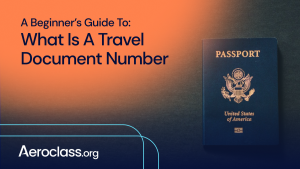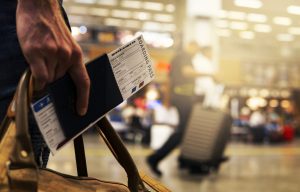The travel document number in an Indian passport is typically located on the first page. It is a 7-character alphanumeric code.
When looking at the biodata page of your Indian passport, the travel document number can be found near the top of the page.This unique identifier is essential for various travel-related processes and documentation requirements.Whether you are applying for a visa, booking international flights, or completing immigration forms, the travel document number plays a crucial role in identifying your passport details.
Familiarizing yourself with the location of this number can save you time and ensure a smooth travel experience.
Introduction To Travel Document Number


The Travel Document Number in an Indian passport can be found on the information page. It is a unique alphanumeric code used for identification during travel. Locate it just below the holder’s photograph.
Purpose Of The Travel Document Number
The travel document number is a unique identifier assigned to each passport, which helps the authorities to track the passport holder’s travel history and other relevant information.
The travel document number is crucial to ensure the authenticity of the passport and prevent any fraudulent activities. The Indian passport travel document number is a 12-digit alphanumeric code, which is unique for every passport holder.
Location In The Passport Structure

The travel document number in an Indian passport can be found on the second page of the passport, which contains the passport holder’s photograph and personal information.
The travel document number is printed in bold, black ink, and is located towards the bottom of the page, just below the passport holder’s date of birth. It is essential to keep the passport safe and secure, as any loss or damage to the passport can result in the loss of valuable travel information, including the travel document number.
In conclusion, the travel document number is an essential component of an Indian passport, which helps the authorities to maintain travel records and prevent any fraudulent activities. It is crucial to keep the passport safe and secure, and the travel document number should only be shared with authorized personnel.
Step-by-step Guide To Finding The Travel Document Numbe

Here’s a step-by-step guide to finding the travel document (passport) number in an Indian passport:
- Locate the Passport Booklet: Ensure you have your physical passport booklet.
- Open the First Page: Open the passport to the first page (inside cover page). This is usually the page with your personal details and photograph.
- Identify the Photo Section: Look for your passport-sized photograph on this page. The photo is usually on the top-left side.
- Find the Passport Number: Just below the photograph, you’ll see a unique alphanumeric code. This is your passport number. In Indian passports, this code generally consists of one letter followed by seven digits (e.g., A1234567).
- Verify: Confirm the passport number by checking it on subsequent pages or in the Machine-Readable Zone (MRZ) at the bottom of the page, where the same number is printed for automated processing.
This passport number is your official travel document number for visa applications, immigration, and other travel-related documentation.
To find the travel document number in an Indian passport, check the first page below the holder’s photograph. The 8 or 9 digit number is labeled as “Passport Number” and serves as the travel document number for the Indian passport.
It is crucial for various travel and official purposes.
Opening Your Passport
Start by locating your Indian passport.
Here’s a step-by-step guide to locating and identifying the travel document number in your Indian passport:
-
Start by Locating Your Indian Passport: Find your physical passport booklet, usually a navy-blue document with the Indian emblem and the words “Republic of India” on the cover.
-
Open to the First Page Inside: Open the passport to the first inside page. This page typically has your photo and personal details.
-
Look for Your Photograph: On this page, in the upper-left section, you’ll see your passport-sized photo.
-
Find the Travel Document Number: Directly below the photograph, you’ll see an alphanumeric code. This code is your passport number, also known as your travel document number, and typically follows a format of one letter followed by seven numbers (e.g., A1234567).
-
Verify by Checking the Machine-Readable Zone (MRZ): At the bottom of the page, you’ll find a sequence of letters and numbers in the MRZ. Your passport number is included here as well, confirming its accuracy.
This number is essential for any official travel documentation and visa processing, so keep it handy and secure.
It is a crucial document for international travel.
Identifying The Relevant Page

Open your passport and flip through the pages until you find the main information section.
This page typically contains personal details, including your name, date of birth, and passport number.
Look for the section labeled “Travel Document Number” or “Passport Number” on this page.
The Travel Document Number is a unique identifier assigned to your Indian passport.
Visual Cues For Quick Identification

Here are some visual cues to help quickly identify the travel document number in an Indian passport:
- Navy Blue Cover: The passport booklet is navy blue with the emblem of India and “Republic of India” printed on the front cover.
- Inside First Page:
- Open to the first page, where your photo and personal details are printed.
- Photograph:
- Look for the photograph at the top-left corner on the inside first page.
- The passport number is just below the photo, so this can be a starting point for orientation.
- Alphanumeric Format:
- Find an alphanumeric code, typically one letter followed by seven digits (e.g., A1234567).
- This format helps differentiate it from other numbers on the page, like the date of birth or issue date.
- Bold and Larger Font:
- The passport number is generally in a bolder and slightly larger font than other details, making it stand out.
- Machine-Readable Zone (MRZ):
- At the bottom of the page, you’ll see two rows of letters, numbers, and symbols in the MRZ. The passport number appears here as well, helping confirm you’ve identified the right code.
Using these cues can make it easy to locate the passport (travel document) number on an Indian passport quickly.
When it comes to locating the travel document number in your Indian passport, visual cues can be incredibly helpful for quick identification.
By understanding the symbols, markings, color, and font clues, you can easily find the essential information you need.
Symbols And Markings To Look For
When identifying the travel document number in an Indian passport, specific symbols and markings can make it easier to locate. Here are the key elements to look for:
-
Indian Emblem on Cover:
- The cover of an Indian passport is navy blue with the Ashoka Chakra emblem at the center. This helps you identify an Indian passport immediately.
-
Passport Title and Emblem Inside:
- On the first page inside, you’ll see the words “Republic of India” and “Passport” along with a smaller version of the Indian emblem near the top.
-
Photograph Section:
- The top-left corner of the first inside page displays the passport holder’s photograph.
- Directly below the photo, look for a unique alphanumeric code—your passport number.
-
Larger, Bold Font for Passport Number:
- The travel document (passport) number is typically in bold and larger font than other details on the page, making it stand out.
-
Machine-Readable Zone (MRZ):
- At the bottom of the first page, you’ll see two lines of text with letters, numbers, and symbols in the MRZ.
- This area contains encoded information, including the passport number, which appears in the first part of the top row, confirming its accuracy.
-
Serial Number on Other Pages:
- Each page has a serial number in a small font, but this is not the passport number. Ensure you’re focusing on the code in the format of one letter followed by seven numbers (e.g., A1234567) just below the photograph.
These symbols and markings help you quickly identify and confirm the correct travel document number on an Indian passport.
One of the primary visual cues for identifying the travel document number in an Indian passport is the specific symbols and markings used.
Look for alphanumeric characters with a distinct format, often located in the personal details page. The travel document number is typically preceded by a specific symbol, making it stand out for quick identification.
Color And Font Clues
Another visual cue to aid in the identification process is the use of color and font. The travel document number is often printed in a bold font and may be in a different color compared to the surrounding text.
These distinctive visual elements make it easier to locate the necessary information within the passport.
Common Misconceptions About Passport Numbers
Here are some common misconceptions about passport numbers that can sometimes lead to confusion:
- Believing the Serial Number on Each Page is the Passport Number:
- Each passport page has a small, printed serial number, but this is not the travel document number. The actual passport number is only on the first page, below the photo.
- Confusing the Passport Number with the Application Number:
- The passport application number (found on the application form or receipt) is different from the passport number. The passport number is assigned after the passport is issued and printed inside the booklet.
- Thinking the Passport Number Changes with Every Travel Stamp:
- Passport numbers remain the same for the validity period of the passport. They do not change with travel stamps or immigration entries.
- Mistaking the MRZ Code for a New Identifier:
- Some people mistake the Machine-Readable Zone (MRZ) code at the bottom of the first page as a unique identifier. While it contains your passport number, the MRZ isn’t a separate number—it’s simply an encoded version.
- Assuming the Passport Number Has No Expiry or Is Permanent:
- A passport number is valid only for the life of the passport booklet. When you renew or replace a passport, a new number is issued.
- Believing the Passport Number is Linked to the Person for Life:
- While linked to your identity, each passport booklet is assigned a new number upon renewal. The number is not a permanent personal identifier.
- Assuming Passport Numbers are the Same for Family Members:
- Passport numbers are unique to each individual, even for family members or children. There are no shared passport numbers, even if applying at the same time.
Clearing up these misconceptions helps avoid issues with travel documentation and keeps your travel smooth and stress-free.
Common misconceptions about passport numbers can lead to confusion and misinformation for travelers. One of the areas that often causes confusion is the distinction between passport numbers and travel document numbers.
Understanding these differences and dispelling misconceptions can help travelers navigate the passport application and renewal process with clarity and confidence.
Passport Number Vs Travel Document Number
Passport numbers and travel document numbers are often mistaken for each other, leading to confusion among travelers.
The passport number is a unique identifier assigned to an individual’s passport and is typically located on the biodata page.
On the other hand, the travel document number is associated with visas, emergency certificates, or other travel documents issued by the government. It is crucial for travelers to differentiate between these two numbers to ensure accurate completion of travel and immigration forms.
Misinterpretations Of Passport Annotations
Annotations within passports, such as entry and exit stamps, visa stickers, and other markings, are sometimes misinterpreted as passport numbers.
These annotations are important for tracking travel history and visa validity but should not be mistaken for the official passport number. Understanding the purpose and placement of these annotations can prevent misunderstandings when presenting the passport for immigration purposes.
Practical Uses Of The Travel Document Number

The travel document number on an Indian passport is typically located on the first page below the holder’s photograph.
Correct! On an Indian passport, the travel document number, or passport number, is typically located on the first page, just below the passport holder’s photograph. It is an alphanumeric code, usually one letter followed by seven digits (e.g., A1234567), and serves as the unique identifier for the passport.This unique identifier is essential for various purposes like visa applications, immigration processes, and travel bookings. It is important to keep this number secure and readily accessible when needed.
Travel Booking Necessities
When preparing for travel, having all the essential booking details and documents in order can make the journey smoother and stress-free. Here’s a checklist of travel booking necessities:
1. Passport and Visa
- Passport: Ensure it’s valid for at least six months beyond your travel dates.
- Visa: Check visa requirements for your destination country and apply early, as processing times can vary.
- Travel Document Number: This is your passport number, required for flights, hotel bookings, and visas.
2. Flight Booking Details
- E-ticket: Confirm your booking and keep a digital and printed copy of your e-ticket.
- Booking Reference: The confirmation or reservation number, often needed for check-in.
- Baggage Allowance: Know the weight limits and restrictions to avoid extra charges at the airport.
3. Accommodation Reservations
- Confirmation Email: Print or save digital copies of your hotel or accommodation reservations.
- Address and Contact Info: Keep the accommodation’s address, phone number, and email handy.
- Check-in/Check-out Times: Familiarize yourself with the schedule to avoid any inconvenience.
4. Ground Transportation
- Airport Transfers: Book airport pick-up or drop-off if needed, especially for late arrivals or departures.
- Rental Car Details: If renting a car, confirm the reservation and know the pick-up and drop-off location.
- Local Transport: Research options like public transit passes or rideshare availability.
5. Itinerary and Activity Bookings
- Tickets for Attractions: Pre-book tickets for popular sites, museums, or events to avoid long queues.
- Tour Reservations: If you’re joining tours, have your reservation details ready, including meeting points and times.
6. Travel Insurance
- Policy Document: Carry a copy of your travel insurance policy, along with contact details for emergencies.
- Coverage Confirmation: Check that your insurance covers medical emergencies, cancellations, and lost luggage.
7. Payment Methods and Foreign Currency
- Credit/Debit Cards: Inform your bank of travel dates to prevent transactions from being blocked.
- Cash: Carry some local currency for immediate needs upon arrival.
- Travel Apps: Download any necessary payment or banking apps for easy transactions.
8. Emergency Contact Information
- Embassy Details: Save the contact info for your country’s embassy or consulate in the destination.
- Local Emergency Numbers: Know the emergency numbers for police, ambulance, and fire services.
9. Copies of Important Documents
- Digital and Physical Copies: Make copies of your passport, visa, insurance, and itinerary and store them separately from the originals.
10. Health Documents
- Vaccination Certificates: Check if the destination requires proof of vaccinations.
- Prescriptions and Medications: Carry necessary medications and prescriptions in case you need refills.
Having these essentials in order can greatly simplify your travel experience, ensuring you’re prepared for both routine and unexpected situations.
Immigration And Customs Processes

Understanding immigration and customs processes can help you navigate international travel smoothly. Here’s a step-by-step guide:
1. Arrival at the Airport
- After landing, follow signs for Arrivals and Immigration. This typically leads to an area where all international travelers must go through passport control.
2. Immigration/Passport Control
- Documents Required: Have your passport, visa (if needed), and arrival/departure card ready. In some countries, you may be asked for proof of onward travel or an address of where you’re staying.
- Biometric Scans and Photo: Some countries may require a fingerprint scan and photo for entry records.
- Questions from Immigration Officers: Be prepared to answer questions about the purpose of your visit, duration of stay, and accommodations. Keep answers concise and honest.
3. Customs Declaration
- Customs Form: You may be asked to fill out a customs declaration form, declaring any goods over the duty-free limit, food, plants, currency, or restricted/prohibited items.
- Red or Green Channel:
- Green Channel: For travelers with no items to declare.
- Red Channel: For travelers declaring goods or currency above the allowed limit.
- Currency Limits: Most countries have a limit on cash or negotiable instruments you can carry without declaring (e.g., $10,000 in the U.S.). Check specific country limits before travel.
4. Baggage Claim
- Collect Your Luggage: Follow signs to the baggage claim area. Screens typically display which carousel corresponds to your flight.
- Lost Luggage: If your luggage is missing, report it immediately to the airline’s baggage service counter.
5. Customs Inspection
- Inspection Process: Customs officers may randomly inspect luggage. Be honest if asked about your items.
- Duty-Free Allowances: Most countries allow a limited amount of alcohol, tobacco, and goods duty-free. Check limits before packing.
- Restricted or Prohibited Items: Declare any restricted items, including certain foods, plants, animals, and medications, as some may be prohibited or require permits.
6. Exiting the Airport
- After customs, proceed to the Arrivals Hall where you can find ground transportation, meet prearranged drivers, or locate your airport transfer.
Tips for Smooth Processing
- Prepare Documents Ahead: Have your passport, visa, and customs form accessible.
- Be Truthful and Courteous: Honesty and politeness can help avoid unnecessary delays.
- Research Destination Requirements: Familiarize yourself with the entry and customs regulations for your destination country, as they vary widely.
Knowing what to expect at each stage can ease the process and help you pass through immigration and customs with minimal hassle.
Troubleshooting Common Issues

When traveling, you may encounter a variety of common issues. Here’s a guide to troubleshooting these problems effectively:
1. Lost Passport
- Immediate Action: Report the loss to the local police and obtain a police report.
- Contact Your Embassy/Consulate: Reach out to your country’s embassy or consulate for assistance in obtaining a temporary passport or replacement.
- Documentation: Provide necessary identification, such as a copy of your passport (if available), passport-sized photos, and travel itinerary.
2. Flight Delays or Cancellations
- Check Airline App or Website: Stay updated on your flight status.
- Contact the Airline: If delayed or canceled, speak with airline staff for rebooking options or compensation.
- Know Your Rights: Familiarize yourself with the airline’s policies regarding delays, cancellations, and passenger rights.
3. Missing Luggage
- File a Report: Report the missing luggage at the airline’s baggage service counter before leaving the airport.
- Keep Receipts: Save any receipts for essentials you need to purchase while waiting for your luggage.
- Follow Up: Regularly check with the airline for updates on your luggage status.
4. Visa Issues
- Double-Check Requirements: Before traveling, confirm visa requirements for your destination country.
- Contact the Embassy: If you face issues at immigration, contact your country’s embassy for assistance and to understand your options.
- Keep Documentation Ready: Have copies of your visa, passport, and travel itinerary to present if questioned.
5. Health Emergencies
- Know Emergency Contacts: Familiarize yourself with local emergency numbers (e.g., 911 in the U.S.) and healthcare facilities.
- Travel Insurance: Ensure your travel insurance covers medical emergencies and know how to use it.
- Carry Medications: Always have necessary medications and prescriptions on hand.
6. Communication Barriers
- Use Translation Apps: Download translation apps like Google Translate for easy communication.
- Learn Key Phrases: Familiarize yourself with basic phrases in the local language.
- Carry a Phrasebook: A small phrasebook can help in a pinch.
7. Cultural Misunderstandings
- Research Local Customs: Learn about cultural norms and practices to avoid offending locals.
- Be Respectful and Open: If you make a mistake, apologize and be open to learning from the experience.
8. Money Issues
- Currency Exchange: If you encounter problems with local currency, locate a reliable exchange service or ATM.
- Notify Your Bank: Before traveling, inform your bank of your travel plans to avoid card blocks for foreign transactions.
- Carry Multiple Payment Methods: Use a combination of cash and cards for flexibility.
9. Accommodation Problems
- Communicate with the Hotel: If there’s an issue with your booking, talk to hotel staff to resolve it. Keep your reservation details handy.
- Consider Alternatives: If the problem persists, look for nearby hotels or accommodations as a backup.
- Online Reviews: Before booking, read reviews to avoid potential issues with accommodations.
10. Safety Concerns
- Stay Aware: Be mindful of your surroundings, especially in crowded areas.
- Emergency Numbers: Know local emergency numbers and the location of your embassy.
- Travel in Groups: If possible, travel with others for added safety.
Final Tip:
Staying calm and collected is essential in any travel-related issue. Often, clear communication and a positive attitude can help resolve problems more effectively.
When it comes to locating the travel document number in an Indian passport, there are some common issues that travelers may encounter.
Understanding how to troubleshoot these issues can be essential for a smooth travel experience. Here are some common problems and their solutions:
Faded Numbers And Legibility Problems
If the travel document number in your Indian passport has faded or is illegible, it can cause inconvenience during travel. The number is a crucial piece of information for border control and immigration processes, so ensuring its legibility is important.
- Here’s what you can do to tackle this issue:
- Use a magnifying glass or a bright light to closely inspect the number.
- If the number is still not clear, take a high-resolution, close-up photograph of the page with the number and keep it handy for reference.
- Contact the nearest Indian embassy or consulate for guidance on the next steps if the number remains illegible.
What To Do If The Number Is Illegible
If you find that the travel document number in your Indian passport is completely illegible, it’s important to take proactive steps to address this issue. Here are some actions you can take:
- Reach out to the passport office or relevant authorities in India to report the issue and seek their guidance on obtaining a replacement passport.
- Be prepared to provide necessary identification and supporting documents to facilitate the reissuance of your passport.
- While waiting for a new passport, carry alternative identification such as a driver’s license or a photocopy of your passport’s information page to present to officials if needed.
Protecting Your Passport Information
Located on the second page of the Indian passport, the travel document number is essential for identification and verification purposes.
Actually, the travel document number, or passport number, is typically located on the first page of the Indian passport, directly below the holder’s photograph.Key Points:
- Location:
- The travel document number can be found on the first page (inside cover), not the second page.
- Purpose:
- It serves as a unique identifier for the passport holder and is essential for various processes, including:
- Flight bookings
- Visa applications
- Immigration checks
- Travel insurance
- It serves as a unique identifier for the passport holder and is essential for various processes, including:
- Format:
- The number is usually in the format of one letter followed by seven digits (e.g., A1234567).
It’s important to have this number readily accessible for any travel-related documentation or inquiries. If you have any other questions or need further clarification, feel free to ask!
Safeguard this information to prevent identity theft and ensure a smooth travel experience. Be vigilant and keep your passport secure at all times.
When traveling, your passport is your most essential document. It’s crucial to safeguard your travel document number, preventing unauthorized access.
Best Practices For Passport Safety
- Store passport in a secure place when not in use.
- Avoid sharing passport details on public platforms.
- Regularly check your passport for any signs of tampering.
Avoiding Unauthorized Access To Your Travel Document
- Do not leave your passport unattended in public areas.
- Use a password-protected safe in your accommodation.
- Be cautious of individuals requesting to see your passport unnecessarily.
Faqs On Travel Document Number In Indian Passport
If you are a frequent traveller, you might have come across the term “Travel Document Number” mentioned in your Indian passport.
Yes, the Travel Document Number in an Indian passport refers to the passport number, which is a crucial piece of information for travelers. Here’s what you should know about it:
What is the Travel Document Number?
- Definition: The travel document number is a unique identifier assigned to each passport holder. It is used for official identification during international travel.
- Format: In Indian passports, this number typically consists of one letter followed by seven digits (e.g., A1234567).
Importance of the Travel Document Number
- Booking and Check-in: Required for booking flights, train tickets, and accommodation.
- Visa Applications: Essential for applying for visas to various countries.
- Immigration and Customs: Needed during immigration checks and customs declarations at airports.
- Travel Insurance: Often required when purchasing travel insurance to ensure coverage.
Where to Find It
- The travel document number is located on the first page of the passport, directly below the holder’s photograph. It’s typically displayed in a bold font for easy identification.
Keeping It Secure
- Record the Number: It’s a good practice to note down your travel document number in a secure location separate from your passport in case of loss or theft.
- Limit Sharing: Share your passport number only with trusted entities (e.g., airlines, hotels) to avoid identity theft.
Understanding the travel document number is essential for anyone who frequently travels internationally, as it plays a significant role in various aspects of travel planning and documentation.
It is an essential identifier that helps immigration officials verify your identity and travel details. In this blog post, we will answer some of the frequently asked questions on the travel document number in an Indian passport.
Renewal And Changes In Document Numbers
If you have renewed your Indian passport, you might have noticed a change in your travel document number. The travel document number in your new passport will be different from the old one. It is because the travel document number is unique to every passport and helps in tracking the passport holder’s travel history.
If you have lost your passport or had it stolen, the travel document number will be different in your new passport. It is crucial to report a lost or stolen passport to the authorities and apply for a new one at the earliest.
Impact Of Passport Expiry On Document Number Validity
The travel document number in an Indian passport is valid until the passport’s expiry date. If your passport has expired, the travel document number will no longer be valid. You will have to apply for a new passport and get a new travel document number.
It is essential to keep track of your passport’s expiry date and renew it before it expires to avoid any inconvenience during international travel.
The travel document number in an Indian passport is an essential identifier that helps immigration officials verify your identity and travel details.
It is unique to every passport and changes with every renewal or replacement. It is crucial to keep track of your passport’s expiry date and renew it before it expires to avoid any inconvenience during international travel.
Frequently Asked Questions
Where Can I Find Passport Travel Document Number?
You can find the passport travel document number on the information page of your passport. It is a unique identifier for your travel document.
Does India Have A Travel Document Number?
Yes, India issues a travel document number for its citizens. This number is used for identification and tracking purposes.
How Do I Find The Document Number On A Passport?
The document number on a passport is located on the same page as your photo and personal information.
It is a combination of letters and numbers and can be found at the top of the page. The document number is unique to each passport and is required for many travel-related activities.
Is The Travel Document Number The Same As The Control Number?
The travel document number is different from the control number. Each serves distinct identification purposes.
Conclusion
Your travel document number in the Indian passport is a crucial identifier for international travel. By locating this number in the passport’s personal information page, you can ensure seamless travel experiences. Understanding the significance of this number will help you navigate immigration processes with ease and confidence.


